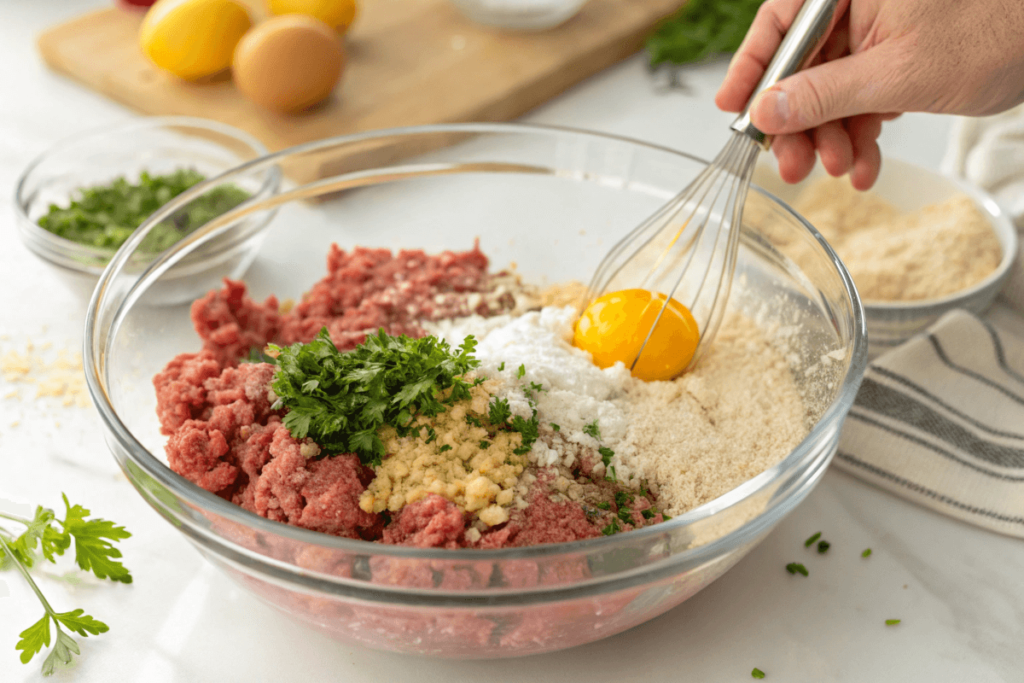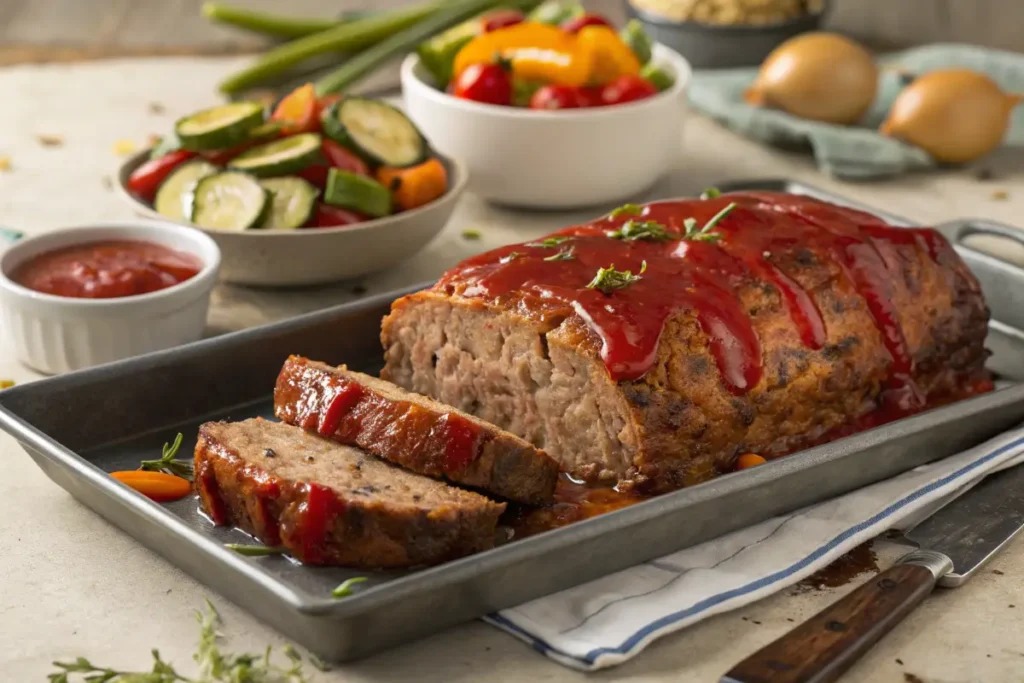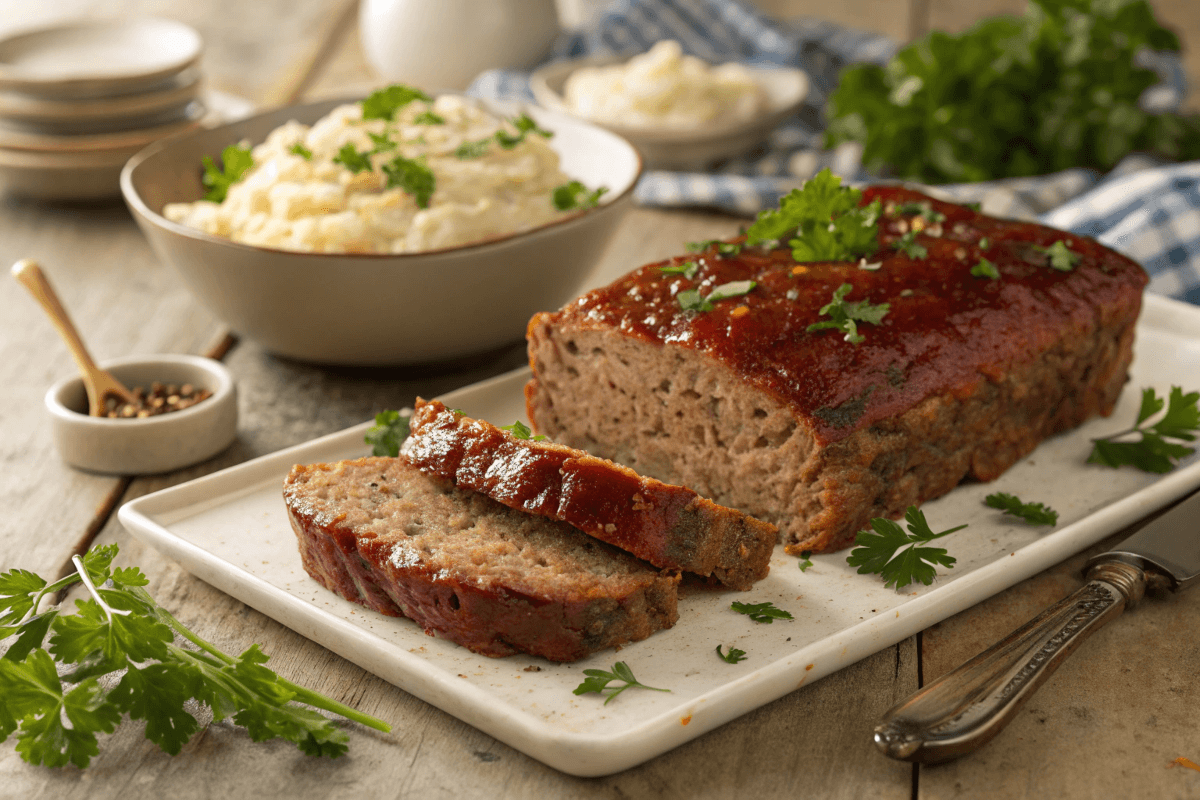Table of Contents
The Secret to Moist Meatloaf: Tips, Tricks, and Expert Advice
Meatloaf is a comforting classic, beloved for its hearty texture and nostalgic charm. Yet, all too often, it suffers the fate of being dry and crumbly, leaving many home cooks asking: What is the secret to moist meatloaf? This article will unravel the mystery by diving into the ingredients, techniques, and cooking methods that ensure a juicy, tender meatloaf every time. Whether you’re a seasoned chef or a novice in the kitchen, these tips will transform your meatloaf into a dish worthy of rave reviews. Let’s get cooking!
Many home cooks wonder, “What is the secret to moist meatloaf?” The key lies in choosing the right ingredients, cooking techniques, and moisture-enhancing elements.
Introduction to Moist Meatloaf
What Makes Meatloaf a Classic Dish?
Meatloaf has long been a staple of home-cooked meals, often associated with warmth and togetherness. Its origins date back to thrifty cooking traditions where scraps of meat were stretched with fillers like breadcrumbs to create a satisfying meal. Over time, this humble dish evolved, with each culture and family adding their own spin. What remains universal is the desire for a meatloaf that’s not just flavorful but irresistibly moist.
If you’ve ever asked yourself, “What is the secret to moist meatloaf?” the answer starts with selecting the right type of ground meat. The fat content in your meat makes a huge difference in the final texture.
Why Moisture Matters in Meatloaf Preparation
Dry meatloaf can ruin the dining experience. A perfect meatloaf should strike a balance: it needs to hold its shape yet stay juicy. Moisture isn’t just about taste; it also affects texture and overall enjoyment. Ingredients like milk, eggs, and finely chopped vegetables infuse the mixture with hydration, while proper cooking techniques ensure that moisture stays locked in.
In this article, we’ll cover everything from selecting the right ingredients to mastering cooking methods, so you’ll never have to serve a dry meatloaf again. Stay tuned for the secrets that will elevate this timeless dish to new levels of deliciousness!
Choosing the Right Ingredients for Moisture
The Role of Ground Meat and Fat Content
When it comes to a moist meatloaf, the foundation lies in the choice of meat. Blending different types of ground meat—like beef, pork, and veal—creates a harmony of flavors and textures. But here’s the kicker: fat is your best friend. Meat with a higher fat content, such as 80/20 ground beef, contributes to a juicier loaf. Lean meat might sound healthier, but it often leads to dryness.
Moreover, don’t shy away from trying alternatives. Ground turkey or chicken can work wonderfully, especially when paired with ingredients that compensate for their lower fat levels.

The Importance of Binders: Eggs, Breadcrumbs, and Beyond
The binders are the glue holding your meatloaf together while maintaining its tender bite. Eggs play a vital role, not only binding the mixture but also adding richness. Meanwhile, breadcrumbs absorb and retain moisture, creating a delicate crumb. If you’re out of breadcrumbs, crushed crackers, oatmeal, or even mashed potatoes can step in.
To ensure your meatloaf isn’t just soft but also bursting with flavor, try soaking your breadcrumbs in milk or broth before mixing them in. This simple step amplifies moisture and takes your dish to the next level.
Adding Moisture with Vegetables: Onions, Bell Peppers, and Carrots
Vegetables are a game-changer for keeping meatloaf moist. Finely grated onions, carrots, or bell peppers infuse the meat mixture with natural juices as they cook. For an extra flavor boost, sauté them lightly before adding them to your mixture. This ensures they release their moisture evenly throughout the loaf, resulting in a succulent, flavorful finish.
Secret Techniques for Locking in Moisture
What Is the Secret to Moist Meatloaf? Using Milk or Broth for Texture
Wondering what is the secret to moist meatloaf? Look no further than milk or broth. Adding a liquid to the mix hydrates the breadcrumbs, creating a silky, tender interior. Opt for chicken or beef broth if you want to amplify savory notes, or use plant-based milk for a unique twist.
The Role of Sauteing Ingredients Before Mixing
Raw vegetables can leave your meatloaf unevenly cooked or watery. A quick sauté of onions, garlic, and other aromatics mellows their flavor and ensures they blend seamlessly into the mixture. This small step can make a big difference in both taste and texture.
Avoiding Overmixing: Keeping the Meatloaf Tender
Overmixing your meatloaf mixture is a common pitfall that can lead to toughness. Combine the ingredients just until they’re evenly incorporated. Handle the mixture with care, treating it as gently as possible to retain a soft and juicy texture.
Cooking Methods for Perfectly Moist Meatloaf
Temperature and Timing: How to Keep Meatloaf Juicy
When it comes to meatloaf, patience pays off. Cooking your loaf at a lower temperature, such as 325–350°F, ensures even cooking and prevents the outer layer from drying out before the inside is done. The sweet spot for doneness is an internal temperature of 160°F, measured with a meat thermometer.
For optimal results, avoid using a loaf pan. Free-forming your meatloaf on a baking sheet allows the edges to brown beautifully without becoming soggy. This simple adjustment makes a world of difference!
Sealing the Deal with Foil or a Water Bath
Keeping moisture locked in during cooking is crucial. Cover your meatloaf loosely with aluminum foil for the first half of the cooking time to prevent excessive drying. Another brilliant technique is placing a water-filled baking dish on the oven rack below your meatloaf. The steam created helps maintain a moist environment.
Resting Before Slicing: Letting the Juices Redistribute
After baking, resist the urge to cut into your meatloaf immediately. If you’re still wondering, “What is the secret to moist meatloaf?” letting it rest for at least 10 minutes ensures that the juices redistribute, keeping every slice tender and juicy.
A crucial yet often overlooked step is letting your meatloaf rest for 10–15 minutes after it’s out of the oven. This resting period allows the juices to redistribute, ensuring that each slice remains juicy and flavorful. Resist the temptation to cut into it right away—you won’t regret the wait!
Sauces and Toppings That Enhance Moisture
Traditional Ketchup Glaze: A Key to Moist Meatloaf
The iconic ketchup glaze isn’t just about flavor; it also helps keep the top of your meatloaf moist. A simple mixture of ketchup, brown sugar, and a splash of vinegar creates a tangy-sweet coating that caramelizes beautifully as it bakes. Apply the glaze during the last 15–20 minutes of cooking for the best results.

Creative Sauces: BBQ, Mushroom Gravy, and More
If you’re ready to break tradition, there are plenty of other options to explore. A smoky BBQ glaze adds a bold flavor, while a rich mushroom gravy pairs beautifully with a hearty loaf. Experiment with what suits your taste and don’t be afraid to get creative.
How to Apply Toppings for Best Results
The secret to a great topping lies in its application. Spread it evenly over the loaf, making sure to coat the sides as well. For an extra layer of flavor, reserve some sauce to drizzle over individual slices when serving. This guarantees every bite is packed with moisture and taste.
For more inspiration, check out our recipe for mushroom-rich dishes to pair with your meatloaf masterpiece.
How to Avoid Overcooking and Keep Meatloaf Moist
Overcooking: A Recipe for Disaster
Overcooking is one of the biggest culprits behind dry meatloaf. Baking your loaf at too high a temperature or leaving it in the oven for too long can sap it of all its juices. Always use a meat thermometer to check for an internal temperature of 160°F. Removing the meatloaf from the oven at just the right moment ensures it stays tender and moist.
Skipping Essential Ingredients
Every ingredient in your recipe plays a role in creating the perfect meatloaf. Leaving out binders like eggs or breadcrumbs can result in a crumbly texture. Similarly, skipping liquids like milk or broth eliminates the moisture your loaf needs. Always double-check your ingredient list to avoid these missteps.
Failing to Properly Measure or Combine Ingredients
It might seem harmless to eyeball measurements, but precision is key when it comes to meatloaf. Too much filler can overwhelm the meat, while too little can make the loaf dense. Moreover, under-mixing or over-mixing the ingredients can impact the final texture. Aim for a balance—combine the ingredients thoroughly but stop as soon as everything is evenly distributed.
Frequently Asked Questions (FAQs)
Why Does My Meatloaf Turn Out Dry?
What is the secret to moist meatloaf? Often, dryness occurs due to lean meat, a lack of liquid ingredients, or overcooking. Using fattier meat, adding moisture-rich elements like sautéed vegetables or milk-soaked breadcrumbs, and keeping a close eye on the cooking time can make a world of difference.
Can I Make Meatloaf Moist Without Breadcrumbs?
Absolutely! Substitutes like oats, crushed crackers, or even cooked quinoa can be used instead of breadcrumbs. These alternatives absorb and hold moisture, keeping the loaf tender and delicious.
What Are the Best Substitutes for Milk in Meatloaf?
If you’re out of milk or need a dairy-free option, try using chicken broth, almond milk, or even yogurt. These substitutes work just as well to hydrate your binders and enhance the loaf’s moisture.
How Do I Prevent My Meatloaf from Falling Apart?
A well-bound meatloaf relies on the right ratio of meat, binders, and liquids. Ensure you’re using enough eggs and breadcrumbs (or substitutes) to hold everything together. Avoid overhandling the mixture, as this can break down its structure.
For more tips and recipe ideas, check out our collection of easy home-cooked meals.
Conclusion and Final Tips
Recap of Key Secrets to Moist Meatloaf
To make the perfect meatloaf, it all starts with understanding what is the secret to moist meatloaf. From choosing the right combination of meats to incorporating moisture-rich binders and liquids, every step plays a critical role. Cooking low and slow, using a glaze to seal in juices, and letting the loaf rest before slicing are simple yet effective techniques to achieve a tender, flavorful result.
Another key takeaway is that experimenting with ingredients, like sautéed vegetables or broth-soaked breadcrumbs, can elevate your meatloaf to new heights. Paying attention to these small details ensures every bite is juicy and delicious.
Encouragement to Experiment and Customize
Remember, recipes are guides, not rules. Once you’ve mastered the basics, don’t hesitate to add your own twist to this classic dish. Swap traditional ketchup glaze for barbecue sauce, or try herbs and spices that suit your taste. Whether you stick to the original or create a signature recipe, the joy of cooking lies in making it your own.
Cooking a meatloaf that’s tender and juicy doesn’t have to be a mystery. By applying these tips, you’ll no longer wonder, “What is the secret to moist meatloaf?” Instead, you’ll confidently prepare a flavorful dish that everyone will enjoy.
For more inspiration, check out additional comfort food recipes at Tester Recipes. Let your creativity shine in the kitchen!

